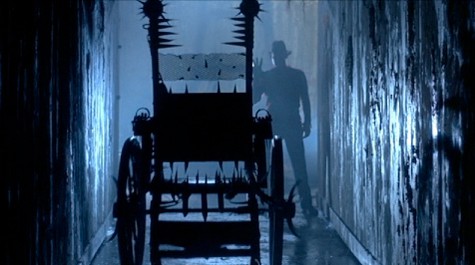Don’t let your impairments hold you back. It’s time to channel your inner Zatoichi and go kick some monster ass! We celebrate the 29th anniversary of the ADA with a look at 25 impactful movies featuring characters with disabilities.
Twenty-nine years ago, on July 24, 1990, the Americans with Disabilities Act (The ADA) was signed into law. It has had a profound effect on the ability for those who have had to struggle with their environment and surroundings, that it helped bring society closer to equal provisions for all. As my day job as an architect, the ADA has had a huge impact on our profession, and it made this country a better place. To celebrate this event, we at The Scariest Things bring you 25 films that showcase movies with heroes and villains who learn to overcome their conditions in horror movies.
The disabled community has a problematic relationship with genre films. Quite frequently the disabled are relegated to being either the monster or the vulnerable and pitiable victim, and occasionally the most annoying character on the screen (ahem… Franklin). Horror, let’s face it, can be cruel. And not just in the blood-splashing gory way. Often, horror will capitalize on, and highlight the physical differences between the villain and the protagonists. Burned, disfigured, and damaged people will often be the monstrous ones.
Not all disabilities get handled equally in Hollywood. Blind people tend to get a decent break of being the noble survivors in all genres of film, but I can’t think of a blind actor yet who has gotten a major role in the movies. (Unlike music where there are many blind stars.) After being largely ignored or forgotten in horror movies, deaf characters recently have had a couple of top-shelf offerings, and we now have a breakout deaf actress horror movie star, so… progress! Sadly, in horror movies, for many years, if you were in a wheelchair, you were essentially dead meat: Friday the 13th Part II anyone? It’s so hard to get representation for mobility-disabled characters, let alone actors, so you hope that when they do appear, they have a meaningful impact. Fortunately, there have been a few standout films that give them some choice roles.
Mental illness is a favorite topic in horror. In horror, most of the time Psychoses=Evil, but there are a lot of movies that take a much more philosophical approach to mental illness, and that can serve as a very long Dead List of all its own. I will save that for another day.
As you look back, the trend line moving movies to shift the view of the disabled from completely demeaning to empowering has made some progress. In recent years we can definitively point to some awesome movies that are true to the roots of horror while also giving some prime protagonists opportunities for them to get some positive time in the spotlight. So, chronologically, here are 25 significant horror movies featuring disabled characters:
EDITORIAL NOTE: We now have a Podcast for you discussing this topic in EPISODE 70!
The Hunchback of Notre Dame (1923)

OK, I’m going to start here, partly to show how far things have come, but also to establish the benchmark of where culture was 100 years ago. Clearly Quasimodo was disabled. His disfigurement really limited what he could do, and his mental state wasn’t exactly… stable. He was the monster. He was also, though, a sympathetic monster. Lon Chaney’s full-bodied performance really sold the plight of the bell ringer, who is gifted kindness by Isabella. Still, it wasn’t until Disney did a sing-along animated feature that Quasimodo got the full redemption. This is a historically significant movie, but it also shows how the disabled got portrayed as monstrous from very early on. It’s a primal fear of somebody who looks different.
Freaks (1932)

The infamous movie that ended the career of director Tod Browning because it was so controversial. He was daring enough to feature real circus performers in this tale of greed and loathing, where the “Freaks” are the sentimental figures and the pretty people are the loathsome ones. Critics accused the movie of exploiting the circus performers, but these actors got PAID, and really, in the 1930s they weren’t likely to get many other roles, so this was their film of a lifetime. Yes, this movie can be awkward at times, but in retrospect, you have to respect the chutzpah of Browning. The world wasn’t ready for Freaks, and it’s a shame for everyone involved.
The Day of the Triffids (1965)
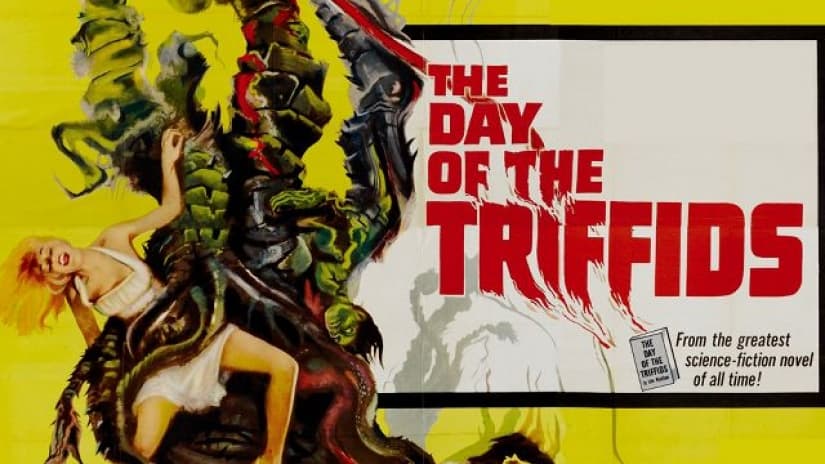
The Day of the Triffids is a British B-Movie with some big ideas. If it wasn’t bad enough that a comet plowing through Earth’s atmosphere was dropping seeds of monstrous mobile carnivorous plants, anyone who stopped to watch the comet pass (a good portion of the world’s population) was struck blind and helpless to the oncoming tide of man-eating vegetables. A bleak and potent science fiction horror tale that was more ominous than most other space invasion movies.
Wait Until Dark (1967)
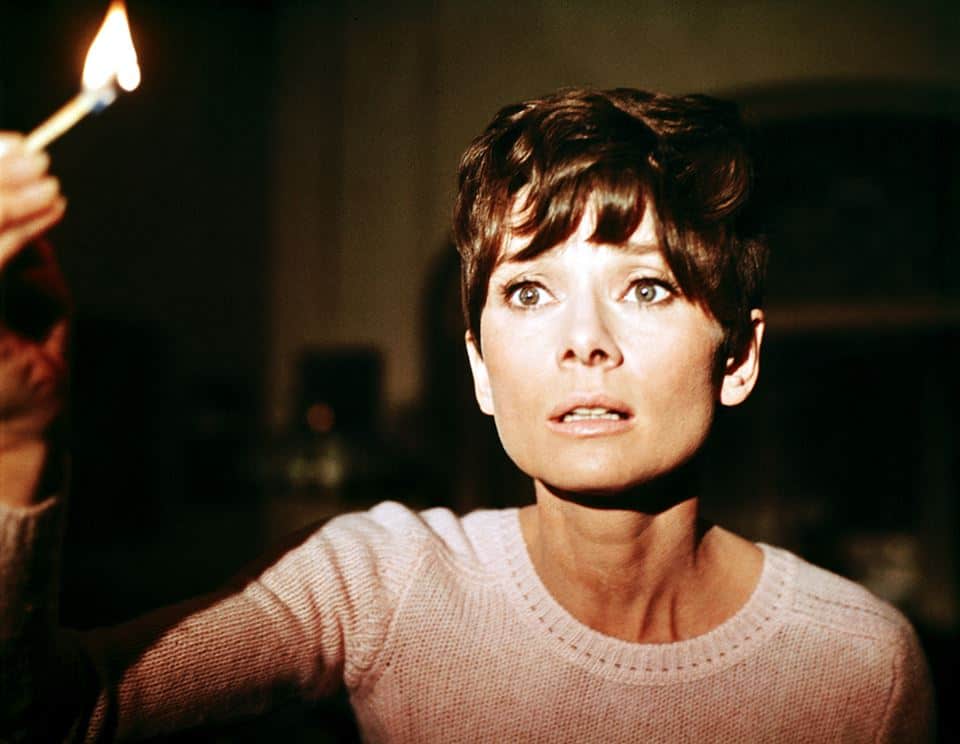
An Oscar-nominated turn for Audrey Hepburn in this fantastic thriller. Hepburn is absolutely captivating and charming as Susy Hendrix, recently blinded in an accident, and fallen prey to nefarious burglar/home invaders. Susy is very clever and is able to piece together inconsistencies and lies of the intruders who are in her house scouring for a stash of drugs that they believe she has in her apartment. While the burglars think they have an advantage over Susy due to her blindness, she manages to turn her condition into an advantage. Absolutely one of the best-scripted thrillers of that era, and a chance to see Hepburn play a mature role with confidence.
The Cat O’ Nine Tales (1971)

There’s something about Giallo directors liking blind characters. Dario Argento cast Hollywood tough-guy Karl Malden to play Franco Arnò, a retired blind journalist to come out and solve a series of murders linked to a pharmaceutical plot involving genetic tinkering. You just can’t trust big Pharma. As Franco uncovers more and more clues to the murders, the eyes of the killers turn to him. And, it’s Franco who gets to turn his condition to his advantage and he gets the drop on the killers. Much more of a thriller than Argento’s usual fare, this movie would fall into the horror or not category, but Argento fans need to see this, his second outing and appreciate the acting of Karl Malden.
See No Evil (1971)

This time it’s Mia Farrow as the blind woman under duress. Sarah (Farrow) is a young woman recently blinded in a horse-riding accident. She is convalescing at her aunt’s stately house, where she grew up, and she knows it like the back of her hand. When stepping away from the house to go visit an old boyfriend, a psychopath murders everyone in the house, and Sarah, completely unaware of the situation, spending the night in the house with three undiscovered bodies lying about. Not nearly as compelling as Wait Until Dark, See No Evil is a portrayal of the blind person as the nearly helpless victim, and Farrow’s fragile figure helps to accentuate the vulnerability. She absolutely sells her condition, but Sarah is very much a damsel in distress and not a modern plucky action hero.
The Texas Chainsaw Massacre (1974)
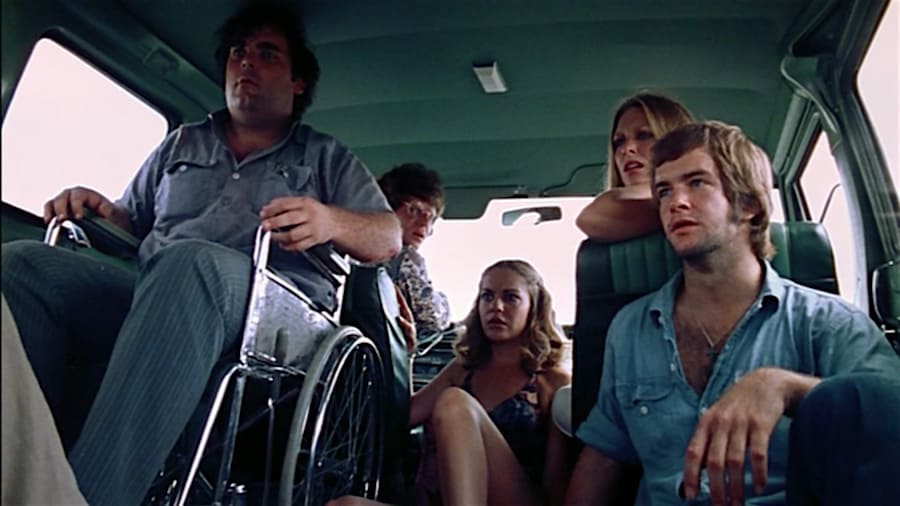
Ah, Franklin. What to do with you. In a group of unlikeable characters, the wheelchair-bound Franklin Hardesty (Paul A. Partain) is the least likable of the lot. He is whiny, obnoxious, and needy. He also gets run through with a chainsaw by Leatherface in one of the most terrifying parts of the movie. (Sorry… I don’t think that’s a spoiler for somebody on this website…) However, in his defense, the Scottish Horror Podcast – Popcorn Horror defends Franklin stating that his behavior is an offshoot of being treated poorly, ignored, and badgered by his companions. The sympathy lies not in his condition, but in his treatment. Then again, he is REALLY annoying, and TST included him in our Most Annoying Horror Jerks in Podcast Episode 48. And, it’s not like The Texas Chainsaw Massacre was afraid of offending anybody. Woke political correctness was not in the cards here. Hooper intended to offend!
Deafula (1975)
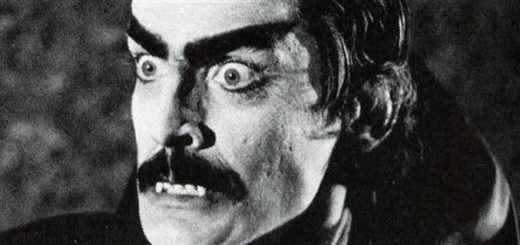
This film, on the other hand, was a HUGE step forward in trying to make films more accessible. It was also a zero budget movie, with almost no distribution. The movie was the first film with all the dialogue in American Sign Language (ASL). The movie is a hot mess though, with poor film stock, shoddy acting, and zero production value. But it is remarkable that they made this film at all. The director, Peter Wolf, ended up doing two more ASL films. This movie was brought to our attention by our friends at Portland at the Movies, as this film was filmed here in Portland. You can find this film in ten-minute segments on YouTube, or, if you’re lucky enough to live in Portland, there’s a copy of it at Movie Madness. Certainly, one of the strangest versions of Dracula you’ll ever run into.
The Beyond (1981)
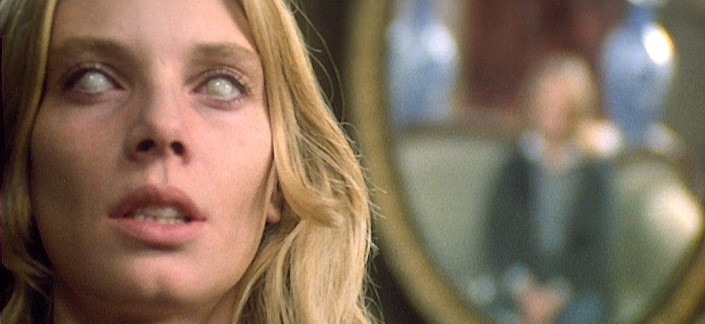
The blind woman as a mystic seer. Emily (Cinzia Monreale) plays a New Orleans mystic who plays something of the Graeae in this Lucio Fulci Giallo classic. This is a role that dates back to antiquity, wherein the blind person has sixth sight into something that the rest of the world just can’t perceive. In this case, Emily is warning Liza Merril (Catriona MacColl) that the hotel that Liza just inherited is sitting on top of a GATEWAY TO HELL. Blind people tend to know these things. Liza should have listened to her and gotten the hell out of the gateway to hell.
Silver Bullet (1985)

The Silver Bullet is not just a reference to the necessary ammunition to off a werewolf, but it also refers Marty’s (Cory Haim) fantastic motorcycle-wheelchair hybrid that his Uncle Red (The inimitable Gary Busey) built for him. Based upon the Stephen King novel Cycle of the Wolf, this movie gave us a disabled kid who has been empowered and lifted up from his fantastic jalopy, and the generosity of his uncle. Haim is a plucky kid, and though the movie itself can be a bit of a predictable piece, he was the disabled kid who other kids could look up to, as he took on the big bad wolf. Plus bonus points for Gary Busey.
A Nightmare on Elm Street 3: The Dream Warriors (1987)
This may be a case of one step forward, two steps back. Dream Warrior Will (Ira Heiden) is a nerdy Dungeons and Dragons playing paraplegic boy, who along with Nancy and several other children in dream therapy takes on Freddy Kreuger and beat their nightmares. But, Will fails. Freddy taunts Willy with an inquisition ready wheelchair, but Willy fights back, summoning his wizard dream likeness, only to get killed by Freddy for his efforts. Willy’s character is rather arch and shallow character. The chair was seen as a makeshift prison, not exactly the most enlightened take on the subject.
Monkey Shines (1988)
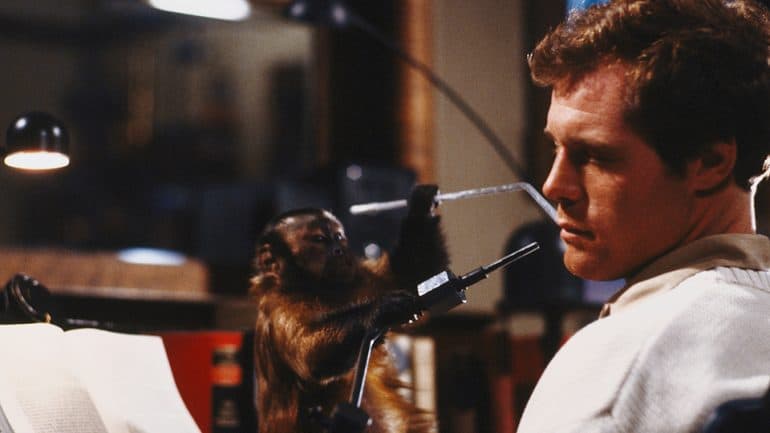
George Romero’s study of a man (Jason Beghe) struck down by a truck and left quadriplegic, and nursed by an adorable but murderous little monkey is one of the most compelling movies featuring a quadriplegic protagonist ever made. It’s a bittersweet tale of a man trying to come to grips with his new condition, and channeling it into his primate companion. One of the most underrated horror movies of the 1980s.
Misery (1990)

Being disabled doesn’t mean being permanently disabled. Certainly not according to the ADA. Novelist Paul Sheldon (James Caan) has survived a horrific automobile accident, only to be “rescued” by his biggest fan, Annie Wilkes (Kathy Bates). As he recovers, he is encouraged to continue writing, but when he tries to leave, and more egregiously when he tells Annie that he’s not going to continue the stories that she loves so much, she decides to keep him in place by hobbling him, in the famous ankle-breaking scene. You’re going to need those 1:20 accessible ramps and lifts, Mr. Sheldon, good thing there’s an ADA!
Army of Darkness (1992)

The best amputee prosthetic ever! Ash Williams and his signature chainsaw arm are the ultimate example of making lemonade out of lemons around. It’s ridiculous to think, but Ash is one of the most badass amputees in all of horror. (Although scroll down for another prime example of badass amputees). Granted, the whole thing is absolutely ridiculous, but at no time do you ever feel bad for Ash and his chainsaw appendage. You also could have picked Evil Dead II for this spot, but in Army of Darkness, he’s fully embraced his prosthetic. Jamie Lannister eat your heart out!
Alien Resurrection (1997)
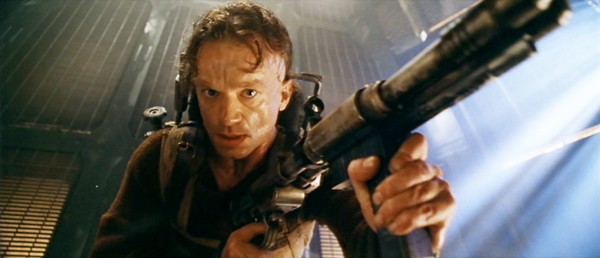
Say what you want about Alien Resurrection (yeah, it’s not most people’s favorite of the franchise), but Dominique Pinon’s rough and tumble paraplegic Vreiss was a great character. Pinon is one of Jean-Pierre Jeunet’s favorite actors to work with, as he is a magnetic actor, particularly given his diminutive stature and exaggerated facial features. Pinon, like his co-star Ron Perlman, look like they’ve stepped out of a cyberpunk fairy tale, and it gave the cast a real edgy look. The raggiest of the ragtag crew trope. Vreiss’s wheelchair is hiding components of a potent arsenal, and he is one tough little S.O.B. and isn’t going to be anybody’s victim.
The Eye (2002)
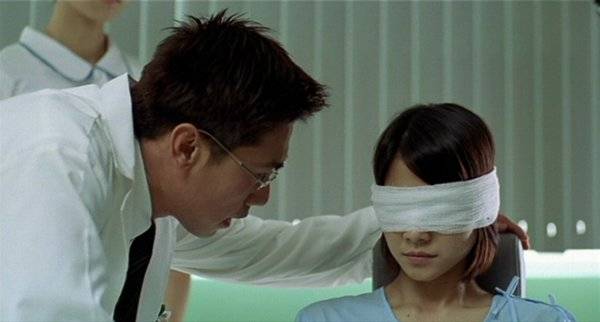
One of the best horror movies to come out of Hong Kong, and maybe one of the last of the type you’ll see coming out of China for a while, as the Chinese censor crackdown on ghost movies. The Eye is a story of a teenager, blind since she was two years old, who gets corneal transplants to give her sight. When she gets her vision back, she is initially delighted, but then is horrified when she realizes that she’s seeing ghosts that foretell gruesome deaths. What was meant to be a blessing turns out to be a curse instead. Perhaps blindness, for her, was better.
Land of the Dead (2005)
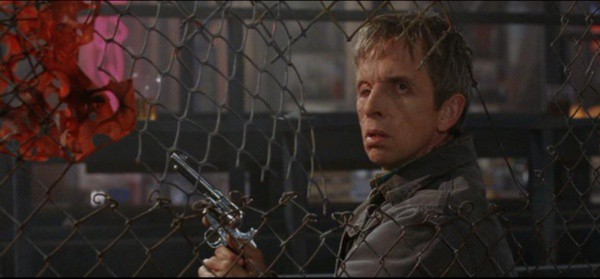
Leave it to George Romero to change things up a bit. In a world where the dead are coming back to life and eating people, it’s good to have loyal, and skilled companions. Charlie (Robert Joy) is just that guy. He also clearly is mentally developmentally disabled, and half of his face got severely burned at some point. He’s sort of a post-apocalyptic Lenney (Of Mice and Men). Usually, someone like Charlie would be the Monster or the Victim, but Romero decided to make him an integral part of the hero squad. He is puppy-dog loyal to zombie hunter Riley (Simon Baker) and is a crack shot with a rifle or pistol. Charlie’s got guts, alright, and he is incredibly brave to a fault, as he tends to be reactive and impulsive. True, he’s a bit broadly drawn, but so is everybody in a Romero zombie movie. You root for Charlie, and (spoiler alert) it’s rewarding to see a character like him survive to the end of the movie. A lesser film would have had him make a stupid mistake and become zombie chow.
Planet Terror (2007)

Cherry Darling (Rose McGowan’s) prosthetic machine gun leg is 100% impractical. It is also 100% cooler than your average prosthetic leg. Robert Rodriguez’ exploitation film homage is soaked in absurdity stew, but just as with Ash Williams, this woman does not need your pity. She’ll cut you down before she lets that happen! The movie is pure gonzo mayhem, and McGowan gamely displays all the gun-fu action you could possibly want. It must be a bitch to keep that muzzle clear, though. Perhaps one day we’ll get a one-two combination of Furiosa and Cherry to form a pair of super badass amputee ladies!
Blindness (2008)
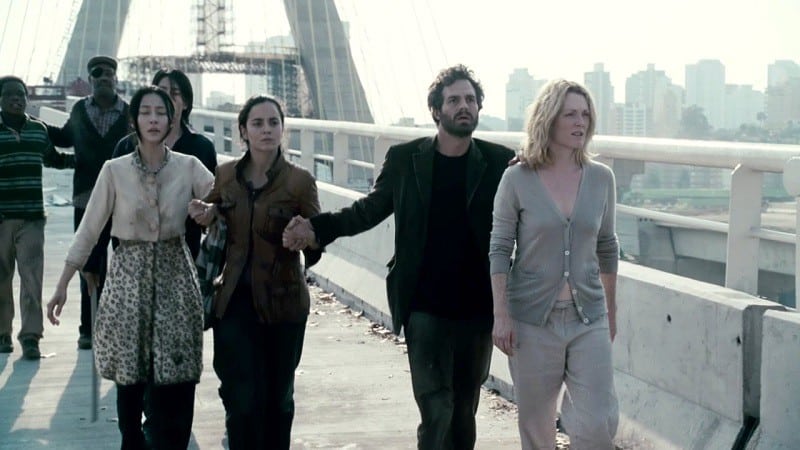
It’s the blindpocalypse! A different take on blindness, where the common perception is that things go dark. Instead, things go very white and bright in this story of an epidemic of blindness across the world. This movie heavily leans into science fiction more than horror perhaps, but the consequences are certainly scary. Julianne Moore and Mark Ruffalo do good work as the leads here, as the world spins into chaos with this rapidly spreading condition. The film has a definite artistic bent about it, all desaturated and flat, but the decision to have no character names is maddening, and the ending feels a bit focus tested. Still, a compelling watch, and makes you consider “What would I do in this situation?”
Blindness also shows up in our Big List of Pandemic and Infectious Horror.
Julia’s Eyes (2010) A.K.A. Los Ojos de Julia
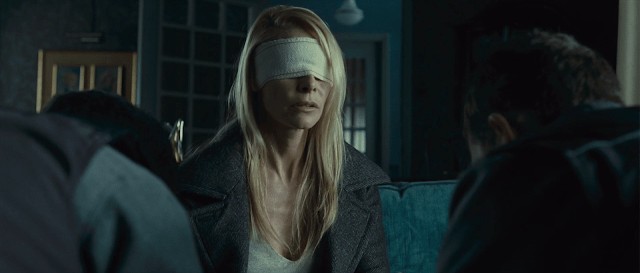
Here’s one you may have missed. Julia (Belén Rueda) is a woman who is going blind, and to make things worse, her twin sister, Sara, was found having hung herself. Julia believes that she was murdered, and is convinced that Sara was murdered, and in a race against her fading eyesight tries to investigate who the killer or killers are. The bodies stack up, and this Spanish Indie horror piece really turns the tension screws on the audience. This movie forces you to peer into the darkness, just like Julia, and it amplifies the very effective jump scares. Oh… it’s also produced by some guy named Guillermo Del Toro.
Late Phases (2014) A.K.A. Night of the Wolf
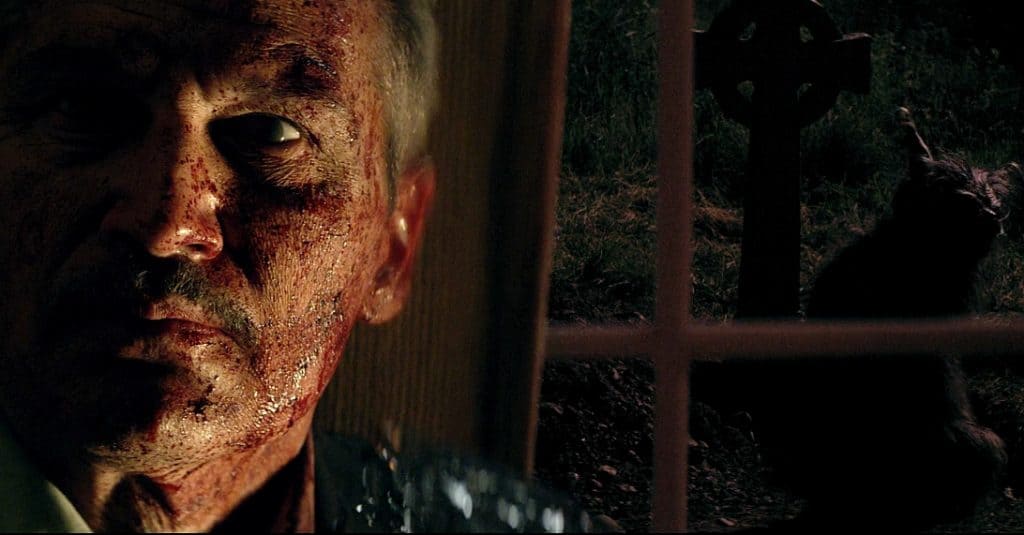
A recent favorite of mine. Nick Damici plays Ambrose McKinley, a blind retiree who is checking into a retirement community that just so happens to have a werewolf problem. Late Phases deals with the combination of the elderly and the disabled and how they can feel overlooked and coddled by their loved ones, when really, what Ambrose wants to do is to protect his new community and find out what is behind all the bloodshed in his new neighborhood. A great sleeper horror film of recent vintage. Ambrose is a 100% pure tough guy and a warrior through and through.
Don’t Breathe (2016)

Are the disabled helpless? Uh… nope! That assumption is completely turned on its ear by Stephen Lang’s ferocious and memorable take as the blind veteran who has his home broken into by a group of young burglars. He is powerful and frightening, and the internal game of cat and mouse between him and the young thieves will indeed have you holding your breath through the movie. Yes, Lang is monstrous, but it is not his blindness that makes him imposing. He does harbor some nasty secrets that prevent him from becoming an admirable man fighting for house and home, but the movie does a great job of switching the sympathies of the characters throughout.
Hush (2016)

Kate Siegel stars in and co-wrote Hush with Director Mike Flanagan about a deaf-mute writer living in forested solitude, who has a masked stalker (John Gallagher Jr.) break into her house looking to kill her. Situationally harrowing, the movie becomes a tense thriller that will have you waving your arms at the screen to try and warn Maddie (Siegel) about the threats within. The challenge of overcoming this struggle becomes central to the plot and is executed very, very well.
A Quiet Place (2018)

This is the big one, right? Hugely successful, and completely immersive. John Krasinski’s magnum opus was authenticated by having the wonderful Millicent Simmonds, a young deaf actress, playing Reagan, in a world where silence is so important. I believe that Simmonds should have been nominated for the best-supporting actress at last year’s Oscars. She was a layered and complex character. Frustrated with wanting more freedom, and wanting to explore in the dangerous world, she got to display the full range of acting skill and unloading a ton of emotional weight to this story. Not since Marlee Matlin have we had a more promising deaf actress on the big screen. What she does next will be certainly worth watching.
Bird Box (2019)
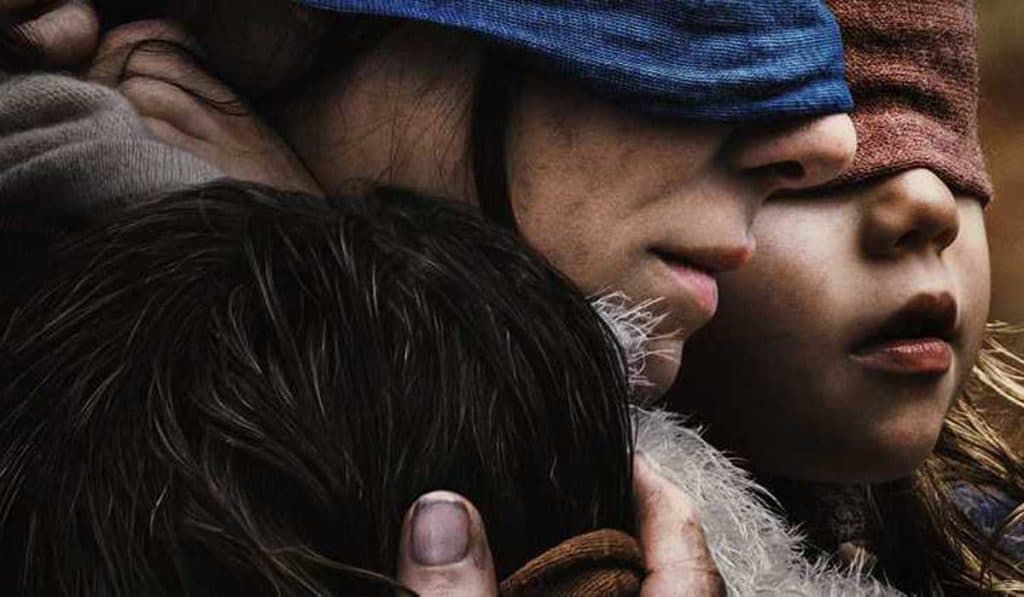
Something of a companion piece to A Quiet Place, this movie works on the premise of if we can see you, you can’t see me. Rather like the Bugblatter beast from The Hitchhiker’s Guide to the Galaxy. Sandra Bullock does outstanding work, per usual, as a mother trying to guide her family through turbulent, untrusting times in a world where you need to go into voluntary sensory deprivation (cover your eyes!). Hampered by the need to see the monsters, as it’s one thing to hold your monsters back, and something altogether less satisfying not to show them at all, Bird Box was nevertheless a big win for Netflix original programming.
EPILOGUE
If you want to go super brainy and read an interesting take on whether there has been much progress in the representation of the disabled, you can check out Hailey Walker’s Assumption College Thesis. It’s a dense collegiate abstract, but it puts into clarity the issues with how people with disabilities get portrayed on screen. I am a bit more optimistic than she is, but she makes some great points.



